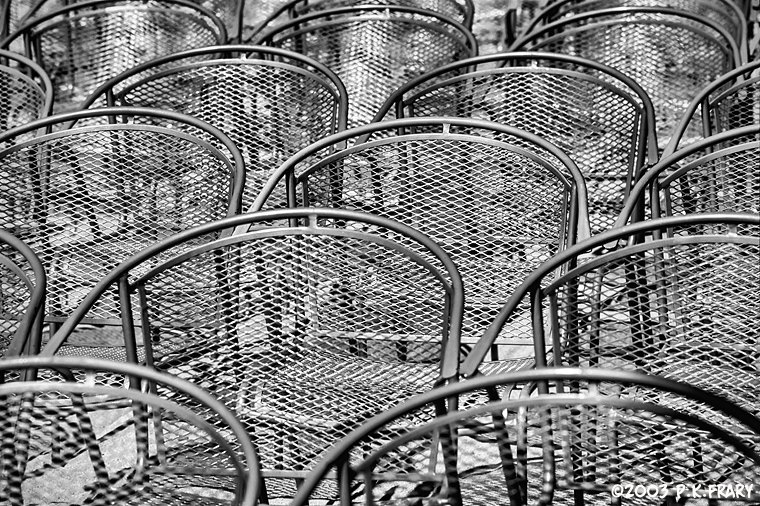.•
Canon
EF 70-200 4L USM
L Optic on a Budget
Peter
Kun Frary
.
.
If you like
sharp, contrasty images, save your money for
the best lenses you can muster. Ultimately,
the caliber of your images is mainly determined by
the quality of the lens and your technique,
not the camera. Quality lenses are an
investment for the future as they will work
on all EOS cameras from film to the latest digital.
Chairs | Waikiki | Canon EOS 3,
EF 70-200 4L USM and Provia 100F

The medium
telezoom—70-210, 70-200 or 80-200—has been
the mainstay of many amateurs and pros alike
since the 1980s. These focal lengths are
perfect for portraits, landscape, outdoor sports and isolating details,
yet are hand holdable.
This review consists of my opinions and observations as a hobbyist. No scientific measurements, MFT charts or pixel peeking comparisons will be found here.
 Compatibility Compatibility
The EF 70-200 4L USM lens works on all Canon EOS DSLR cameras such as the 6D, 5D MK III, Rebel SL3 and 90D. It will also work on EOS R and M series mirrorless cameras with a mount adapter. It does not fit non-Canon cameras such as Pentax, Nikon, Fuji, etc.
 Construction Construction
The optical design and
anti-reflection coatings of today's zooms have
evolved to the point that the best examples
rival prime lenses. Unfortunately, most
consumer zooms are cheap plastic affairs with
silk-screened symbols and coarse zoom and
focus action. Canon's EF 70-200 4L USM bucks
this trend and combines modern optical design
and AF with the durable construction and
silky zoom and focus action of yesteryear. At
$650, it is more affordable than the EF 70-200
4L IS USM ($1200) or EF 70-200 2.8L IS USM
MKII ($2500), but offers similar build and optical
quality.
The hybrid
metal (barrel) and plastic (trim) construction and
quality components make it tough as nails,
but it's a reasonable 705g (24 oz.). Both the
zoom and focus mechanisms are internal.
Fortunately, internal mechanisms
are less prone to sucking in dust than front extension
designs.
The filter size is 67
mm, making filters expensive if you're used to buying 52 and 58mm filters.
Canon
EF 70-200 4L USM | EOS 5D, EF 24-105 4L IS USM and Reflectors

The EF 70-200 4L USM is
a classic two-touch design: focus ring near
the end of the barrel and zoom ring near the
mount. The large twist action zoom ring is
smooth and fast. The
manual focus ring is large, ribbed,
rubberized and nearly as smooth turning as
the manual lenses of yesteryear. The focusing
ring feels too far out on the barrel. At
least I never confuse it with the zoom ring!
Once you get used to the design, handling is
nimble and decisive.
The off-white
finish is elegant and the overall appearance similar
to
the EF 70-200 2.8L IS USM and other "great
white L glass." The off-white finish screams
"L glass" and draws attention to you.
However, this lens stays cool even in the blazing
Hawaiian sun. Unfortunately, my black EOS bodies don't.
 Auto
Focus Auto
Focus
This lens sports a
ring-type USM (Ultrasonic Motor) that drives
a lens group between the
front element and diaphragm.
The combination of internal focus and ring-type USM yield very fast AF.
The front element does not rotate nor does the barrel
expand or
contract during focus or zoom
operations. Surprisingly, the AF of my EF 70-210 3.5-4.5
USM is even faster, perhaps due to the small
elements in the rear focus group.
The motor
of the EF 70-200 4L USM is silent during AF,
but I hear a pianissimo "rolling" sound as
the elements move on the gear train. It
has FTM, allowing you to manually focus
without switching out of AF mode. If you
prefocus manually, the distance window in
meters and feet is extremely useful. It also
sports an AF limiter.
The zoom's AF worked
flawlessly on my EOS 3, Elan 7NE, A2, 10D, 20D, 40D and 5D MKII bodies. That is, AF is fast, accurate and decisive.
Moreover,
the maximum aperture of F4 is sufficient to fully
enable the center AF cross sensor on late
model EOS
bodies.
Sand Island Cranes | EOS 20D and EF 70-200 4L
USM | Although this lens
has good flare resistance, a brilliant
sunset may create ghosting problems. You can see ghosting just to the left of center.

 Image Quality Image Quality
Paired with my EOS 3 and EOS 5D,
the EF 70-200 4L USM proved to be an
extremely sharp
and contrasty zoom, a level above my EF 70-210
3.5-4.5 USM. Images were
sharp edge to edge, with only slight softening in corners
at F4. The constant F4 aperture is a big plus
for hand meter users and those that prefer
manual or aperture priority exposure modes.
An advantage of this lens
over consumer zooms is it exhibits little degradation
of
image quality at large apertures or the long
end. In other words, it's sharp wide open and
across the zoom range. Stopped down to F8 or
F11, chromes from this lens and the EF 70-210
3.5-4.5 USM are indistinguishable.
Nevertheless, top image quality wide open is
essential if you frequently hand hold your
camera.
The contrast and snap
of this lens is apparent even through the
viewfinder. After all, there's some
exotic glass in there, 1 Fluorite and 2 UD
elements. The long end is not as sharp as my
EF 200 2.8L USM prime, but it's very
close in the center. Image magnification is a
little less than my EF 200 2.8L USM, leading
me to suspect the zoom is just shy of
200mm. There is little distortion—barrel
distortion is apparent at close focus—but
flare is extremely well controlled. With full
frame coverage (35mm), some flare and
ghosting may occur with bright sunsets.
Smaller formats, e.g., APS and digital,
exhibit little or no flare or ghosting.
Nevertheless, this lens is more flare
resistant than any telezoom I have
owned—almost as good as a Canon prime. You
should use the huge lens shade (ET-74) to
help keep flare in check.
Extenders
Most L series
telephotos and telezooms are designed to use
L series Extenders. The rear of these lenses
have a space for the protruding element of
the Extender (that's why Canon didn't use the
faster rear element focus group). With 16
elements in the barrel of the EF 70-200 4L
USM, I'm not excited about adding 5 to 7 more
elements with an Extender. Light must really
struggle to make it through all that glass
(21 or more elements). Extenders are best
used with prime lenses as there is less
degradation of image quality. Nevertheless,
the Canon Extender 1.4x allows a reasonably
well performing 98-280 F5.6 zoom.
Unfortunately, bright light sources—e.g.,
sunsets, street lights, car headlights—will
generate more flare with an
Extender.
Ala Moana Beach Park,
Honolulu HI | EOS 3,
EF 70-200 4L USM and Fujichrome
100

Tripod
Collar
The EF 70-200 4L USM has
the option of using a tripod collar, i.e.,
Tripod Mount Ring A (white, #2889A002).
Although this lens is so light a tripod
collar is unnecessary, a collar makes tripod
use easier, especially verticals. If you
want a tripod collar, you may save a few bucks by
purchasing the Tripod Mount Ring A (black,
#2888A002). It's exactly the same as Tripod
Collar "A" (white) except for the black
finish. The tripod collars are
interchangeable between the EF70-200 4L USM,
EF 80-200 2.8L, EF 200 2.8L USM, EF 300 4L USM
and EF 400 5.6L USM. The Tripod Mount Ring B
will not fit.
There is one potential
gotcha with the Elan 7E/BP-300 and the
EF 70-200 4L USM with Tripod Mount Ring A: the
BP-300 will not clear some tripod heads. For
example, the protruding front grip of the
BP-300 hits the mounting plate of my Bogan
3265 Ball Head. I can mount the rig backwards
and it works fine, but it's awkward with the
release lever in the front. Most screw-in
tripod heads are fine as the mount rides a
little lower. Quick-release heads are prone
to this problem because the QR plate elevates
the camera slightly. With larger cameras such
as the EOS 3, 20D or 5D there
is more clearance and, hence, no problem.
Gentle Waves at Aloha Tower | EOS 5D and EF 70-200 4L
USM

 Musings Musings
Compared to the
EF 70-210 3.5-4.5 USM and EF 100-300 4.5-5.6
USM, this lens is big, white and draws
attention to itself. Of course, that's the
price you pay for constant aperture and
internal zoom and focus. Plus, the EF 70-200
4L USM is nearly as long as the EF 70-200 2.8L
USM and, thus, requires the same amount of
space in a camera bag. It's heavier than
most consumer zooms so it balances better on
heavier bodies, e.g., EOS 3, 5D
or 7D. You
may find it front heavy on a Rebel Ti or XS. Without
the BG-E2 (battery grip) I find
it front heavy on a 40D.
 Final
Blurb Final
Blurb
If you mainly use the long end of a telezoom, buy
the EF 200 2.8L USM or EF 300 4L IS USM
instead. However, if you need a telezoom,
this one is among the best. The EF 70-200 4L
USM has similar build and optical quality as
the famous EF 70-200 2.8L USM, but at half the
price, weight and shy a F stop. Most pros buy
the EF 70-200 2.8L IS USM as the extra stop may
mean the difference between getting an
important shot (paycheck) or not. For
discriminating hikers, travelers and amateurs
this zoom deliverers quality without breaking
their shoulder and bank.
Japanese Hula | EOS 10D and EF 70-200 4L
USM

 Specifications Specifications
Focal Length: 70-200
mm
Aperture: F4 to
32
Lens Construction: 16
elements in 13 groups with 1 Fluorite and 2
UD elements
Min. Focusing Distance:
1.2 m/3.9 ft.
Diameter & Length:
76 x 172 mm/3 x 6.7 inches
Weight: 705 g/24
oz.
Included Accessories:
ET-74 Lens Hood and Storage Bag
Cost: $650
More Images taken
with the EF 70-200 4L USM (click to
enlarge)
6/01/2002 | Updated 10/10/2023
 ©Copyright 2002-24 by Peter Kun Frary | All Rights Reserved
©Copyright 2002-24 by Peter Kun Frary | All Rights Reserved
|








 Compatibility
Compatibility







